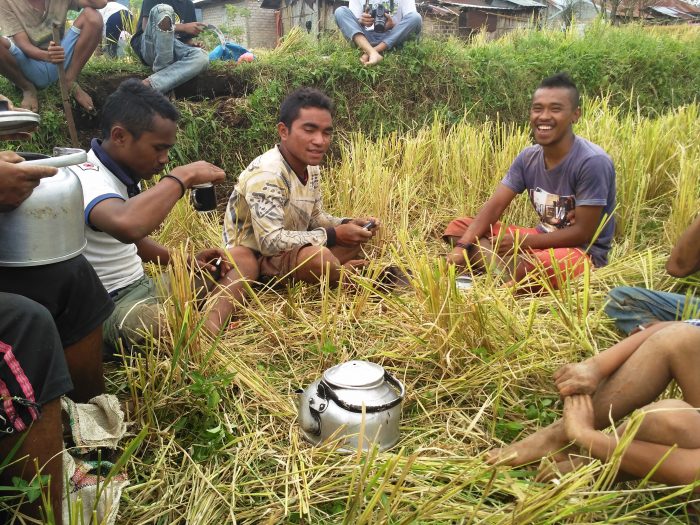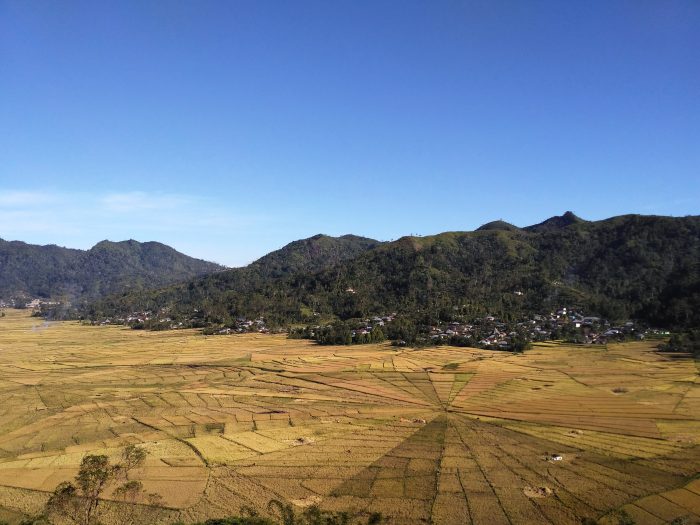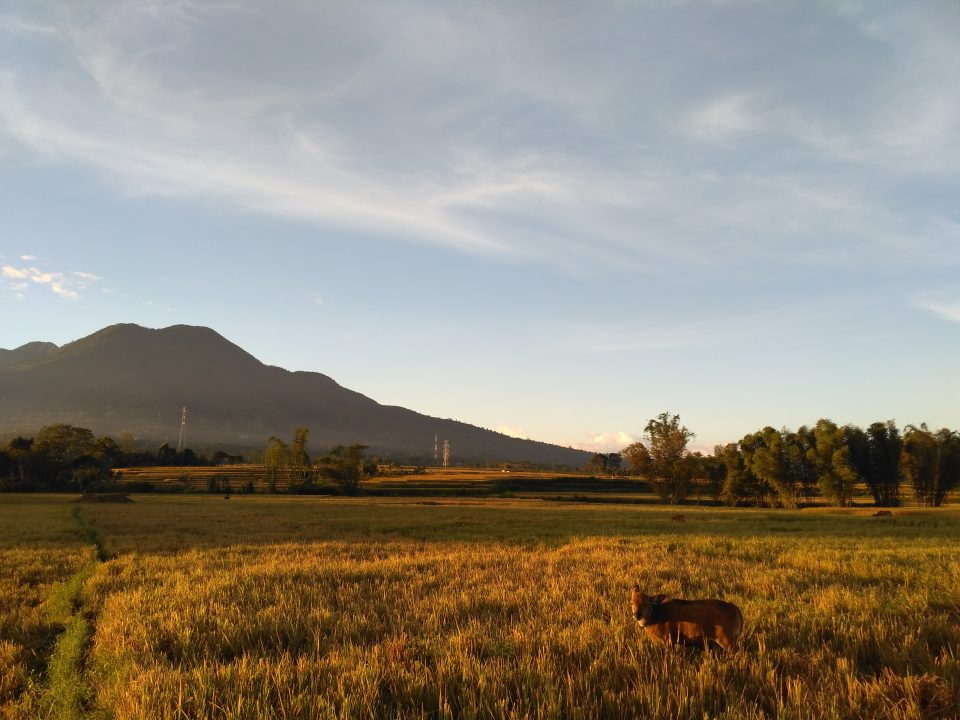Rice fields do not only mean a land to sow seeds or even a field for farming seasonal crops which are vulnerable to pests.
It is actually more than that. Cancar, a small village in the west of Flores island is capable of showing how a rice field could be the source of local wisdom, to celebrate the traditions and culture of the locals. I was lucky enough to finally witness the enchanting harvesting season in Cancar.
The runway gate of Komodo Airport kindly welcomed me as the plane was landing. It was sunny at the airport that I didn’t spot any grey clouds. The distance from Komodo Airport to Cancar in Manggarai District is approximately 120 kilometres and it can be travelled by car or minibus, taking around four hours. After a long ride, the sun had set and the wind was getting colder as the minibus went through one city then another. The mesmerising view of green hills finally turned into an overlay of the golden rice fields with a few houses. Finally, the driver announced with a yawn that we had finally arrived in Cancar.

A Cup of Manggarai Coffee
I arrived in Cancar in the middle of May, when the harvesting season begins and the weather is very cold. During my stay in this village of a thousand rice fields, I boarded at Faldo’s house. Faldo was a friendly, young guy that I met while strolling around the traditional market. His house was located right in front of his own rice field, which was ready to be cut as the colour of the rice had turned to gold and the grains could be peeled off easily. While we were chilling in the living room with his family, Faldo asked me to go to the rice field the next day as he would reap the rice plants; and of course, I said yes.
The following day, we went together to the rice paddy to reap the rice plants. Everyone had their own role. The women, with a full-faced powder coverage, were responsible for flicking the rice plants, while the young men, including Faldo and me, were in charge of transporting the cut rice plants to the mill. It was not that difficult but it was quite challenging for me. All I needed to do was wait for the sack to be filled and then take it away. But we had to be careful when crossing the rice field, otherwise, we would slip down into it. In another place, there were a lot of men who would organise the rice plants before milling them. Everybody carried out their tasks happily and so did I.
The most interesting thing during the harvest time was enjoying a cup of Manggarai coffee and traditional snacks at break time, while also sitting together in the rice field talking about many things, such as about harvesting and their plans to send their children to university. Everyone blended in together without having to try to fit in. For Faldo, rice paddy is a home to share the togetherness with all of his family members.

Rat Hunting
After collecting all of the rice plants, the next step is milling the rice with the milling machine. The women were not involved in this process, but the men were. It took two hours to finish the whole task. After all of the work had finished, we did a thing that had been long-awaited; rat hunting! This activity was the reason why the kids went to the rice field and waited for the harvesting process to end.
In order to hunt rats, we needed to prepare a piece of wood and a crowbar. The first thing to do was finding the hole in the rice field that was used by the rats to be their den. One of us would dig the hole to drag the rats out of their den, while the others would be standing guard around the holes. When the rats came out of their den, we were ready to smack them with a piece of wood. It was very vicious indeed.
If the rats could escape from the crowd, they would run after them together. And if they lost track of the rats, they would split up. Once one of them found the rats again, they would scream and hunt them together. Faldo told me a funny story that while they were digging the hole, instead of inviting rats to come out, a snake appeared and they would run away. Turns out they were afraid of snakes too.
After they had hunted the rats, they would be consumed as a snack or even a meal. They would grill or fry the rats, but mostly they fried them. I tried one, and for me, it tasted like chicken. But I didn’t manage to finish the whole meal as I was still thinking about the brutal hunting from the previous evening.
However, the rat hunting was quite useful, as Faldo admitted that since the rats were hunted during the harvest season, their population was reduced significantly during the cultivating season. Therefore, the rice field would be safe from rats which were a pest to the farmers.

Tracking the spider-web rice field
Rice paddies are an icon of Cancar. Their existence cannot be separated from the history of civilisation of the locals. My interest in this fact made me pay a visit to Cara Village, a 20-minute walk from Cancar’s downtown. There was a spider-web rice field, or lingko, in which a central point was surrounded by several triangle-shaped rice fields.
If we looked from the top of the hill, it would be clear to see that it looked like a giant spider-web. The proportional size of the rice field made it perfect. Its strategic location around the green hills and the golden rice plants during the harvesting season makes an amazing view. On the other hand, I was thinking how could this rice field exist?
For the locals, lingko was not merely an impressive view, but also an identity which held a history of civilisation in the past. From a well-known public figure in the village, I learned that lingko was the result of the inheritance distribution system in the past. At that time, the tribal chief would share his land as a legacy to his people by making a spider-web-shaped rice field. Each rice field from the centre to the outer layer would represent each village which would be divided into small slots for each family. They thought that spider-web was a proportional shape for a land division.
I must admit that the spider-web rice field was an astonishing historical heritage. Unfortunately, the ownership of some slots of rice field now belongs to the capitals as they have sold their rice field. I paid a visit to the centre of the lingko and met the local farmers. Some of them were farm workers and they were worrying that the rice field would be switched to other uses to meet the owners’ desires. I cannot imagine what it would be like if it were changed into a resort or other modern buildings. I really hope not.




